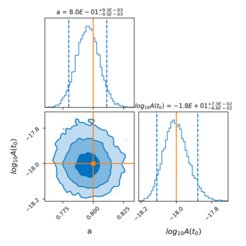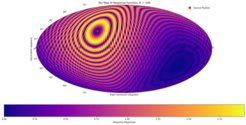Dr. Anjana Ashok
Postdoc in the Pulsar Timing Array (PTA) group

What is your current position at our institute?
I am a Postdoc in the Pulsar Timing Array (PTA) group, collaborating with the Continuous Gravitational Waves group. In a couple of months, I’ll start a postdoc position with the NANOGrav group at Oregon State University.
What is your academic education?
- Junior Scientist/Post-doc, Continuous Gravitational Waves group, Max Planck Institute for Gravitational Physics, Hannover
- PhD - Max Planck Institute for Gravitational Physics, Hannover
- Masters in Physics - National Institute of Technology Karnataka, India
- Bachelors in Physics - University of Calicut, India
How and when did you choose to do physics?
At age 8, my imagination was sparked by a space-themed picture book that my aunt gifted me. The pictures hinted at a mystery, and I wanted to explore it. I decided that I’d go there. A couple of years later, I realized that being an astronaut demanded physical endurance, a pursuit I wasn't particularly drawn to. Being an ‘astronomer’ seemed more satisfying. This plan lived on in the back of my mind, when senior school physics interested me. From there, it was all a clear path: physics in college, physics in university and now a PhD where I specialized in gravitational wave astronomy.
What would you recommend to a young woman wanting to start a career in physics?
If there is a particular theme that interests you, find a group that works on the topic and do short projects with them during which you'll learn about (i) the topic itself and (ii) the process of research.
What is your vision for women and girls in science in 20 years?
Academia where there are as many women as men so that the workplace (including social areas and everyday interactions) is balanced, where all voices contribute and are heard with equal weight.
Can you please describe your research?
Pulsar Timing Arrays (PTA) measure gravitational-wave signals in the residuals after fitting a timing model to the observed arrival times of pulses from a network of pulsars. In June 2023, PTA collaborations worldwide announced varying levels of evidence for a stochastic gravitational wave background signal in their dataset. Such a background is produced by the superposition of continuous gravitational waves (CW) from binary supermassive black hole systems. Against this backdrop, my current research focuses on two key topics - (i) techniques to detect individual CW signals by leveraging the directionality encoded in the antenna patterns of the collection of pulsars. (ii) wavelet-based techniques to detect and analyse non-stationary features in the data, hints for which have been reported by one of the PTA collaborations.
Do you have a favourite figure to illustrate your current research?

Non-stationarities in the data manifest in a time-varying power spectral density S(f,t). For simulated data with a power-law PSD of time-varying amplitude with initial amplitude A(t0) and time evolution parameter ‘a’, the figure shows that our method accurately recovers the true parameters (in orange).

This plot is a preliminary result from the continuous waves method, yet to be published.
Why did you choose the Max Planck Institute for Gravitational Physics for your research?
The environment at AEI Hannover is one where I experienced a lot of growth. Some of the factors that contributed to this are – the accessibility to leading experts in the field, a culture that does not belittle/discourage anyone's questions/ideas and the resources to perform your research in peace. Hence, it was straightforward to choose to continue doing my research here.
Learn more about Dr. Ashok’s research at https://inspirehep.net/authors/1889521.


